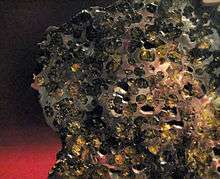Brenham (meteorite)
| Brenham | |
|---|---|
 | |
| Type | Stony–iron |
| Class | Pallasite |
| Group | Anomalous Pallasite (Pallasite-an)[1] |
| Composition | 8.5% Ni, 21.5 ppm Ga, 55.5 ppm Ge, 0.023 ppm Ir |
| Country | United States |
| Region | Kansas |
| Coordinates | 37°34′57″N 99°9′49″W / 37.58250°N 99.16361°WCoordinates: 37°34′57″N 99°9′49″W / 37.58250°N 99.16361°W |
| Observed fall | No |
| Fall date | 20,000 years ago |
| Found date | 1882 |
| TKW | 4.3 tons[1] |
|
| |
Brenham[1] is a pallasite meteorite found near Haviland, a small town in Kiowa County, Kansas, United States. Pallasites are a type of stony–iron meteorite that when cut and polished show yellowish olivine (peridot) crystals.
The Brenham meteorite is associated with the Haviland Crater.
History
In 1949, a collector named H.O. Stockwell discovered a mass of 450 kilograms (990 lb), known at the time as "The World's Largest Pallasite Meteorite."
In October 2005, geologist Philip Mani and meteorite hunter Steve Arnold located and recovered the largest fragment ever found of Brenham: a single pallasite mass of 650 kilograms (1,430 lb).[2]
Classification and composition
Brenham is an anomalous pallasite (Pallasite-an).[1]
Specimens
The 650 kilograms (1,430 lb) mass found by Philip Mani and Steve Arnold is currently housed in a private collection in Texas.
The 450 kilograms (990 lb) mass discovered in 1949 is called The Space Wanderer and is on display at The Big Well in Greensburg, Kansas. It was found and hand dug in the Ellis Peck farm, east of Greensburg.
The world's largest collection of Brenham meteorites along with numerous fragments weighing a total of 8,500 pounds are housed at the Kansas Meteorite Museum and Nature Center in Haviland, Kansas owned by Don I. Stimpson & Sheila M. Knepper.[3]
- Fragment housed in the Fort Worth Museum of Science and History
 Specimen almost olivine-less
Specimen almost olivine-less Small slice at the Harvard Museum of Natural History
Small slice at the Harvard Museum of Natural History Meteorite at Big Well museum in Greensburg, Kansas
Meteorite at Big Well museum in Greensburg, Kansas
See also
References
External links
 Media related to Brenham (meteorite) at Wikimedia Commons
Media related to Brenham (meteorite) at Wikimedia Commons- The largest recovered Brenham oriented fragment on World Record Meteorite Website